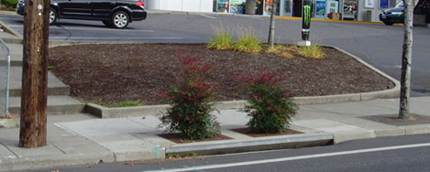

|
Tree box filters |
||
| Applicability | ||
Tree box filters have many of the benefits of rain gardens, and they can actually enhance their function. Tree box filters combine stormwater management principles that focus on natural processes and micro-scale methods and aesthetics, resulting in improved pollutant removal, reliability, construction methods, and maintenance costs. They can also improve the quality of life in urban areas by increasing ecological function and a place’s beauty through the addition of vegetation (See figures 1 and 2 for urban uses).
The filters can help meet stormwater management goals and regulatory requirements for new development, while protecting and restoring streams and watersheds. A measurable benefit of tree box filters is their effect on water quantity and water quality issues. The compact size of tree box filters allows volume and water quality control to be tailored to specific site characteristics. They are most successful at reducing runoff volume and peak discharge rate for small, frequently occurring storms, in which they capture the water quality volume (WQv). The WQv refers to the average amount of stormwater runoff that should be captured and treated to remove most of the pollutants in a storm event. Tree box filters are not designed to capture volumes larger than the WQv or to detain it for extended periods of time. Water quality is improved by using tree box filters through the same physical, chemical, and biological processes used in bioretention cells. According to the Virginia Stormwater Minimum Standard 3.11C, tree box filters can be expected to remove the following pollutants, based on a minimum filter surface area that is 0.33% of the drainage area:
|
||

